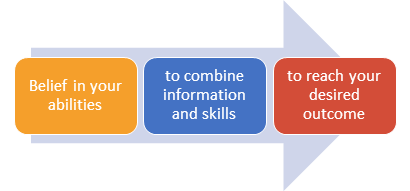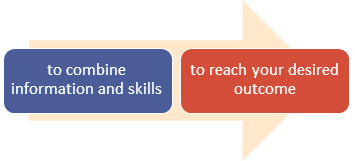Self-Efficacy
This podcast with Cassie Stevens and Lori Scott kicks off a series of podcasts that focus on a group from Educational Service Districts across the state of Washington and their journey to shift statewide inclusion practices through targeted leadership support, professional development, and being accessible to all educators. This series will share the UDL-aligned and UDL-adjacent experiences of building leaders and teachers across Washington, but what I want to focus on here is how they are building self-efficacy.
When you believe you have the ability to pull information and skills together and put them into action so you can produce a desired outcome, you are experiencing self-efficacy (Banduara, 1977).

Let’s pull that apart in a backwards design-y kind of way.
You want to reach a certain outcome, like including more students with disabilities in your classroom for longer periods of time. You know that when students with disabilities are included, their high school outcomes increase (Cole et. al., 2021; Cole et. al., 2022) and you want to be part of that. You have your goal/desired outcome.

When you take one more step back, the theory states that you need to be able to pull together the information you need and activate the skills you have to reach that goal. Within this scenario of inclusion, you gain insights on the types of support a student needs. You realize that the support aligns with support other students need and you feel comfortable weaving that into your lesson and learning environment. You also learn about some support that is unique to a learner (e.g., the student uses a communication board). You immediately realize that you need help understanding how to use this information. Maybe you’ve never taught a student who uses a communication board. It is so new to you, you’re not sure how to move forward.

The theory asserts that teachers need to believe they have the ability, skills and knowledge to meet the stated goal. If that belief isn’t there, movement forward is restricted. But you’re involved in a project that has helped you and others create stronger communication. You reach out to the special education teacher and ask how to incorporate the student’s communication board into your class. The two of you talk about the upcoming lesson, the day-to-day vocabulary that is used in your classroom, and the overall vocabulary that is part of the current unit. You know that the special educator is going to do some pre-teaching with the student and add the new information to the communication board.
With just that step, you start to see greater possibility. You start to believe that you can support this student because you are learning a skill and have gained some knowledge that allows you to move toward your desired outcome.

I believe the Inclusionary Project in Washington brings this theory to life. There are leadership teams across Washington who stepped forward and said, “We want to achieve a goal, but we don’t have the skills and knowledge.” They wanted to place themselves in an iterative learning process (that is continuous, by the way. Implementing inclusive practices is ever evolving). They wanted to reach a point where they believed they could effectively support these learners. They have demonstrated that it’s possible and I can’t wait to share their stories of how they are paving the way so all learners can become expert learners.
References
Bandura, A. (1977). Self-efficacy: Toward a unifying theory of behavioral change. Psychological Review, 84 191–215.
Cole, Murphy, H. R., Frisby, M. B., Grossi, T. A., & Bolte, H. R. (2021). The Relationship of Special Education Placement and Student Academic Outcomes. The Journal of Special Education, 54(4), 217–227. https://doi.org/10.1177/0022466920925033
Cole, Murphy, H. R., Frisby, M. B., & Robinson, J. (2022). The Relationship Between Special Education Placement and High School Outcomes. The Journal of Special Education, 2246692210979. https://doi.org/10.1177/00224669221097945
